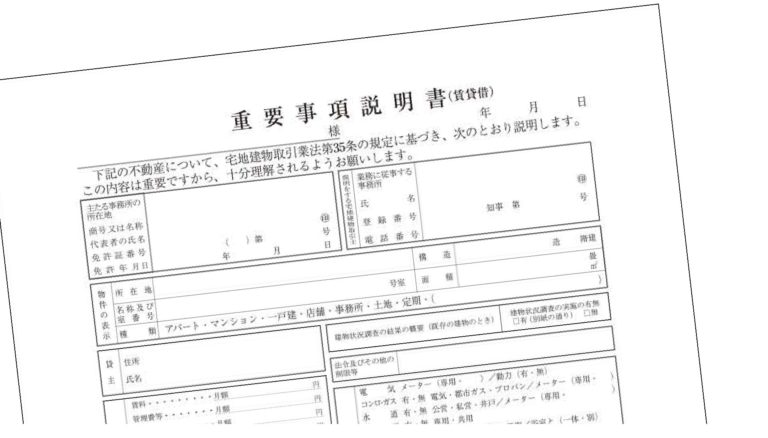What’s the difference between Lease Contract and JYU YOU JIKO SESTUMEISHO=JYUSETSU?
JYUYOU means important, JIKO means Issues. This could be translated as the Property Disclosure Statement of Important Issues.
The lease contract and Important Points Explanation of Property to be Leased will be prepared and issued by the real estate company that acted as an intermediary based on the contract.
Important Points Explanation of Property to be Leased has to be explained verbally by a real estate agent who has to be a licensed 宅地建物取引士[TAKUCHI TATEMONO TORIHIKISHI(real estate agent licensee)
Please understand that it is the role of the explanation of important matters to have the tenant grasp the contents more strongly though it becomes similar contents because it is made based on the contract.
The real estate company that acts as an intermediary will issue two copies of Important Points Explanation of Property to be Leased, and after the names and seals of the real estate company and the tenant are stamped, one copy will be given to each party. It will not be given to the landlord.
In most real estate (rental) contracts, the real estate company acts as an intermediary, but there are some cases where the contract is made directly with the landlord or where the real estate company is the direct lender.
In that case, the obligation to explain important matters is eliminated, so it is considered that the contract is made only by the contract.
Here are contents to be described only in the statement of important matters.
In addition to the terms and conditions of the contract, there are other important details in the statement of materiality.
Explanation of the property
- Matters recorded in the register.
The content of ownership and other rights registered in a land or building. It includes mortgages and leaseholds on mortgages and leaseholds. - Summary of restrictions under the statute
Restrictions based on laws and regulations such as the City Planning Law and the Building Standards Law. These include zoning restrictions on the use of buildings, building-to-land ratio and floor-area ratio that regulate the size of buildings, the relationship between the site and the road, and other regulations that greatly affect the construction and renovation of homes. - Matters relating to burdens on private roads.
If the road on which the site fronts is a private road, describe the location and area of the road, the right-of-way, and whether or not there is a contribution for the use of the road. - Supply and drainage facilities, such as drinking water
Are the drinking water, electricity and gas supply facilities and drainage facilities in readiness for use? The type of supply and the location of buried water and gas pipes. If the facilities are not yet in place and there are plans to develop them in the future, explain whether and how much of a contribution will be made and when they are expected to be developed. - The shape and structure of the land development and building at the completion of construction.
For cases where land development and construction work is not yet completed, the plan shall describe the shape and structure, floor plan, and interior and exterior finishes when construction is completed. - In the case of condominiums
When the property is condominiums, the right-of-way of the site, the management rules, the parking lot, the amount of the management fee and the repair reserve fund, the name of the management company and the management system, etc. are described.
Explanation of Terms and Conditions
- In the sale and purchase agreement for a building with tenants, the timing of deposits, property taxes, management fees, rent and other settlements should be explained.
- Matters concerning the cancellation of a contract
(1) Under what circumstances can the contract be terminated?
(2) What procedures are required?
(3) What effect does the release have? - Estimated amount of damages or penalties
If there is a provision concerning a schedule of damages or penalties, the amount and details of such a provision should be explained. - Security Measures for Deposits and Other Payments
In the case of a sale in which the real estate company acts as the seller, if the deposit or other payment exceeds a certain amount or percentage of the deposit, it is obliged to take measures to protect the deposit and explain the details of the deposit. - Measures to protect payments or deposits
When a real estate company receives money from a buyer, if the amount of money is 500,000 yen or more, it must explain the outline of the security measures as an important matter. - Content of loan mediation
When a real estate company arranges a loan for a buyer, it explains the loan terms and conditions, including the amount and interest rate, as well as what measures it will take if the loan is not obtained. - Measures Related to Liability for Defects
Whether or not you take out warranty insurance on the performance of your liability and, if so, it should be be explained.
Other details that need to be explained
– When the land or building is in a 土砂災害警戒区域 [DOSHA SAIGAI KEIKAI KUIKI] (どしゃさいがいけいかいくいき) “landslide disaster alert zone”
– If the building has been 耐震診断 [TAISHIN SHINDAN] (たいしんしんだん) seismically inspected (only if the building work began before May 1981)
– When a real estate company sells in installments
– If there are any psychological issues that need to be noticed in the property or the surrounding environment
Those things must be explained.
Reference : https://suumo.jp/article/jukatsu/baikyaku/baibaikeiyaku/juyoujikou/

